-
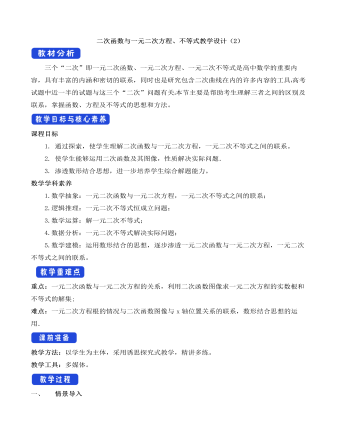
人教A版高中数学必修一二次函数与一元二次方程、不等式教学设计(2)
三个“二次”即一元二次函数、一元二次方程、一元二次不等式是高中数学的重要内容,具有丰富的内涵和密切的联系,同时也是研究包含二次曲线在内的许多内容的工具 高考试题中近一半的试题与这三个“二次”问题有关 本节主要是帮助考生理解三者之间的区别及联系,掌握函数、方程及不等式的思想和方法。课程目标1. 通过探索,使学生理解二次函数与一元二次方程,一元二次不等式之间的联系。2. 使学生能够运用二次函数及其图像,性质解决实际问题. 3. 渗透数形结合思想,进一步培养学生综合解题能力。数学学科素养1.数学抽象:一元二次函数与一元二次方程,一元二次不等式之间的联系;2.逻辑推理:一元二次不等式恒成立问题;3.数学运算:解一元二次不等式;4.数据分析:一元二次不等式解决实际问题;5.数学建模:运用数形结合的思想,逐步渗透一元二次函数与一元二次方程,一元二次不等式之间的联系。
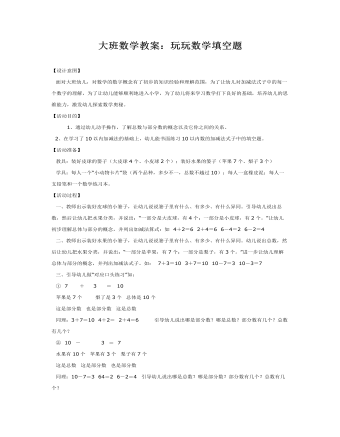
大班数学教案:玩玩数学填空题
【活动目的】 1、通过幼儿动手操作,了解总数与部分数的概念以及它你之间的关系。 2、在学习了10以内加减法的基础上,幼儿能书面练习10以内数的加减法式子中的填空题。 【活动准备】 教具:装好皮球的篓子(大皮球4个、小皮球2个);装好水果的篓子(苹果7个、梨子3个) 学具:每人一个“小动物卡片”袋(两个品种,多少不一,总数不越过10);每人一盒橡皮泥;每人一支铅笔和一个数学练习本。 【活动过程】 一、教师出示装好皮球的小篓子,让幼儿说说篓子里有什么、有多少、有什么异同。引导幼儿说出总数,然后让幼儿把水果分类,并说出:“一部分是大皮球,有4个;一部分是小皮球,有2个。”让幼儿初步理解总体与部分的概念,并列出加减法算式:如 4+2=6 2+4=6 6-4=2 6-2=4 二、教师出示装好水果的小篓子,让幼儿说说篓子里有什么、有多少、有什么异同。幼儿说出总数,然后让幼儿把水果分类,并说出:“一部分是苹果,有7个;一部分是梨子,有3个。”进一步让幼儿理解总体与部分的概念,并列出加减法式子。如: 7+3=10 3+7=10 10-7=3 10-3=7
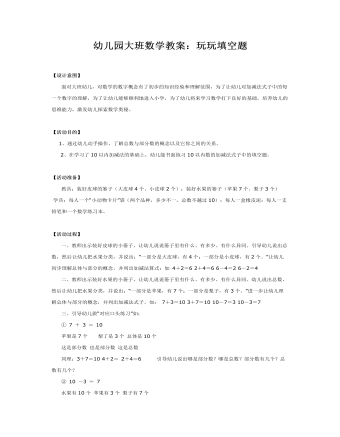
幼儿园大班数学教案:玩玩填空题
【活动目的】 1、通过幼儿动手操作,了解总数与部分数的概念以及它你之间的关系。 2、在学习了10以内加减法的基础上,幼儿能书面练习10以内数的加减法式子中的填空题。 【活动准备】 教具:装好皮球的篓子(大皮球4个、小皮球2个);装好水果的篓子(苹果7个、梨子3个) 学具:每人一个“小动物卡片”袋(两个品种,多少不一,总数不越过10);每人一盒橡皮泥;每人一支铅笔和一个数学练习本。
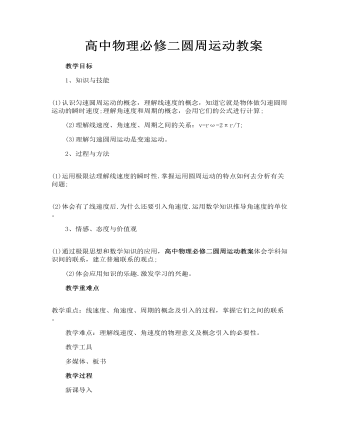
高中物理必修1教案高中物理必修二圆周运动教案
一、描述圆周运动的物理量 探究交流 打篮球的同学可能玩过转篮球,让篮球在指尖旋转,展示自己的球技,如图5-4-1所示.若篮球正绕指尖所在的竖直轴旋转,那么篮球上不同高度的各点的角速度相同吗?线速度相同吗? 【提示】 篮球上各点的角速度是相同的.但由于不同高度的各点转动时的圆心、半径不同,由v=ωr可知不同高度的各点的线速度不同.
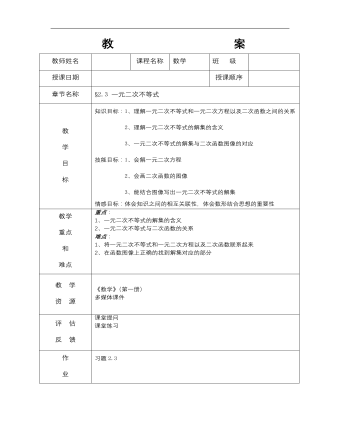
【高教版】中职数学基础模块上册:2.3《一元二次不等式》教案设计
教师姓名 课程名称数学班 级 授课日期 授课顺序 章节名称§2.3 一元二次不等式教 学 目 标知识目标:1、理解一元二次不等式和一元二次方程以及二次函数之间的关系 2、理解一元二次不等式的解集的含义 3、一元二次不等式的解集与二次函数图像的对应 技能目标:1、会解一元二次方程 2、会画二次函数的图像 3、能结合图像写出一元二次不等式的解集 情感目标:体会知识之间的相互关联性,体会数形结合思想的重要性教学 重点 和 难点重点: 1、一元二次不等式的解集的含义 2、一元二次不等式与二次函数的关系 难点: 1、将一元二次不等式和一元二次方程以及二次函数联系起来 2、在函数图像上正确的找到解集对应的部分教 学 资 源《数学》(第一册) 多媒体课件评 估 反 馈课堂提问 课堂练习作 业习题2.3课后记本节课内容是比较重要的,是一元二次方程、一元二次函数、一元二次不等式的结合,相关知识点融会贯通,数形结合的思想方法在这有很好的运用。三种情况只要讲清楚一种,另外两种可由学生自行推出结论。
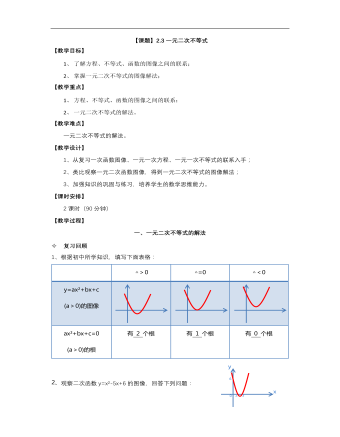
【高教版】中职数学基础模块上册:2.3《一元二次不等式》优秀教案
【教学目标】1、了解方程、不等式、函数的图像之间的联系;2、掌握一元二次不等式的图像解法;【教学重点】1、 方程、不等式、函数的图像之间的联系;2、 一元二次不等式的解法。【教学难点】 一元二次不等式的解法。【教学设计】 1、从复习一次函数图像、一元一次方程、一元一次不等式的联系入手;2、类比观察一元二次函数图像,得到一元二次不等式的图像解法;3、加强知识的巩固与练习,培养学生的数学思维能力。【课时安排】 2课时(90分钟)【教学过程】一、一元二次不等式的解法² 复习回顾1、根据初中所学知识,填写下面表格: △>0 △=0△<0y=ax²+bx+c (a>0)的图像ax²+bx+c=0 (a>0)的根有 2 个根有 1 个根有 0 个根2、观察二次函数y=x²-5x+6的图像,回答下列问题:(1)当y=0时,x取什么值?(2)二次函数y=x²-5x+6的图像与x轴交点的坐标是什么?(3)当y<0时,x的取值范围是什么?总结:由此看到,通过对函数y=x²-5x+6的图像的研究,可以求出不等式x²-5x+6>0与x²-5x+6<0的解集

人教版新课标小学数学二年级上册表内乘法(一)教案
(6)交流。6的乘法口诀一共有几句?口诀中的第一个数与算式中的第二个因数相同,表示什么?口诀中的第二个数与算式的第一个因数相同,表示什么?相邻两句口诀的积相差几?哪几句难记一些?你用什么方法记呢?怎样记住"三六十八"、"四六二十四"两句口诀?教师在学生发言的基础上鼓励学生大胆说、想出不同记口诀的方法。(7)应用"做一做"第1题(学生半独立完成):①用6根小棒摆1个六边形;②摆2个六边形要用多少根小棒?你是怎样想的?(想口诀"二六十二"。)③运用所学的口诀口答摆4个、6个、3个、5个六边形所需要向小棒数。"做一做"第2题(独立完成):①将第2题改为填空题,在圆圈内填写正确的积;②口答得数,并说一说所用口诀。
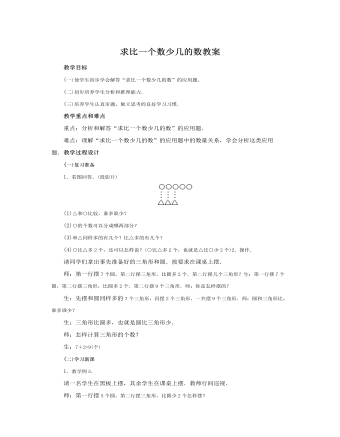
人教版新课标小学数学二年级上册求比一个数少几的数教案
课堂教学设计说明求比一个数少几的数的应用题是低年级教学的一个难点.为了分散难点,在复习准备阶段做了孕伏.如:圆比三角形多2个,也可以说三角形比圆少2个.为了突破难点,让学生动手摆、动口说、动笔写,全方位地调动学生的各种感官参与教学全过程,使学生在参与学习的活动中领悟出“求比一个数少几的数”的应用题仍然是把较大数看作两部分组成的,从大数中去掉大数比小数多的部分,就是小数与大数同样多的部分,也就是小数的数值.也可以通过“假设同样多”去透彻地理解比一个数少几的实际意义.确实使学生理解和掌握了这类应用题用减法计算的道理和解答方法.为了让学生进一步加深理解和掌握“求比一个数少几的数”的应用题的数量关系和解答方法,在巩固练习的最后设计了一组对比题目.

新人教版高中英语必修3Unit 1 Festivals and Celebrations-Reading for writing教学设计二
Step 3 Analyzing article structureActivity 31. Teachers raise questions to guide students to analyze the chapter structure of this diary and think about how to describe the festival experience. (1)What should be included in the opening/body/closing paragraph(s)?(2)How did the writer arrange his/her ideas?(3)What kind of interesting details did the writer describe?(4)How did the writer describe his/her feelings/emotions during the event?2. Students read and compare the three sentence patterns in activity 2. Try to rewrite the first paragraph of the diary with these three sentence patterns. After that, students exchange corrections with their partners. Such as:●This was my first time spending three days experiencing the Naadam Festival in China’s Inner Mongolia Autonomous Region and it was an enjoyable and exciting experience. ●I'll never forget my experience at the Naadam Festival because it was my first time to watch the exciting Mongolian games of horse racing, wrestling, and archery so closely. ●I'll always remember my first experience at the Naadam Festival in China’s Inner Mongolia Autonomous Region because it was so amazing to spend three days witnessing a grand Mongolian ceremony. Step 4 Accumulation of statementsActivity 41. Ask the students to read the diary again. Look for sentences that express feelings and emotions, especially those with the -ing form and the past participle. Such as:● …horse racing, wrestling, and archery, which are all so exciting to watch. ● some amazing performances● I was surprised to see…● I was a little worried about. . . ● feeling really tiredOther emotional statements:●I absolutely enjoyed the archery, too, but the horse races were my favourite part. ●I'm finally back home now, feeling really tired, but celebrating Naadam with my friend was totally worth it. ●He invited me back for the winter to stay in a traditional Mongolian tent and cat hot pot. I can’t wait!2. In addition to the use of the -ing form and the past participle, the teacher should guide the students in the appreciation of these statements, ask them to memorize them, and encourage them to use them reasonably in writing practice.

新人教版高中英语必修3Unit 4 Space Exploration-Listening&Speaking&Talking教学设计二
The themes of this part are “Talk about how to become an astronaut” and “Talk about life in space”. As Neil Armstrong said “Mystery creates wonder and wonder is the basis of man’s desire to understand. Space is difficult for human to reach, therefore, humans are full of wonders about it. However, if wanting to achieve the dream of reaching the Moon, some of our human should work hard to be an astronaut at first. Part A(Talk about how to become an astronaut) is a radio interview in a radio studio, where the host asked the Chinese astronauts about his story how to become an astronaut. Yang Liwei told his dreamed to be an astronaut since childhood. Then he worked hard to get into college at 22. The next 10 years, he gradually became an experienced pilot. At the same time, to be an astronaut, he had to study hard English, science and astronomy and trained hard to keep in good physical and mental health and to practise using space equipment. Part B (Talk about life in space) is also an interview with the astronaut Brown, who is back on the earth. The host Max asked about his space life, such as his emotion about going back the earth, the eating, shower, brushing, hobbies and his work. Part A and Part B are interviews. So expressing curiosity about the guests’ past life is a communicative skill, which students should be guided to learn.1. Students can get detailed information about how Yang Liwei became an astronaut and Max’s space life.2. Students learn to proper listening strategy to get detailed information---listening for numbers and taking notes.3. Students can learn related sentences or phrases to express their curiosity like “ I wish to know...” “I’d love to know...”4. Students can learn more about the space and astronauts, even be interested in working hard to be an astronaut
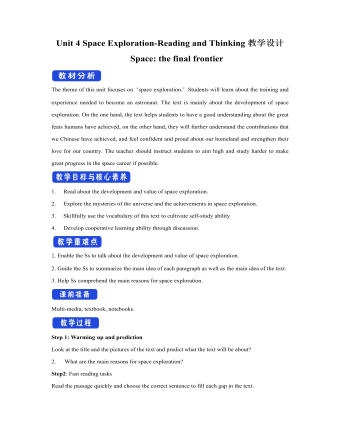
新人教版高中英语必修3Unit 4 Space Exploration-Reading and Thinking教学设计二
The theme of this unit focuses on “space exploration.” Students will learn about the training and experience needed to become an astronaut. The text is mainly about the development of space exploration. On the one hand, the text helps students to have a good understanding about the great feats humans have achieved, on the other hand, they will further understand the contributions that we Chinese have achieved, and feel confident and proud about our homeland and strengthen their love for our country. The teacher should instruct students to aim high and study harder to make great progress in the space career if possible.1. Read about the development and value of space exploration.2. Explore the mysteries of the universe and the achievements in space exploration.3. Skillfully use the vocabulary of this text to cultivate self-study ability 4. Develop cooperative learning ability through discussion.1. Enable the Ss to talk about the development and value of space exploration.2. Guide the Ss to summarize the main idea of each paragraph as well as the main idea of the text.3. Help Ss comprehend the main reasons for space exploration. Multi-media, textbook, notebooks.Step 1: Warming up and predictionLook at the title and the pictures of the text and predict what the text will be about?2. What are the main reasons for space exploration?
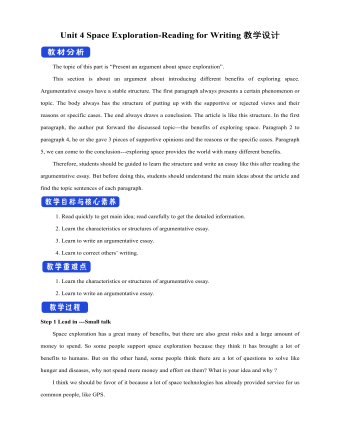
新人教版高中英语必修3Unit 4 Space Exploration-Reading for Writing教学设计二
⑦在我看来, 探索太空是值得的。As far as I am concerned, it is worthwhile to explore the space.Step 10 Writing---draftRecently, students in our class have had heated a discussion on whether space is worth exploring. Students hold different ideas about it.30% of us think space exploration is not worthwhile. They think space is too far away from us and our daily life and is a waste of money. And the money spent on space exploration can be used to solve the earth’s problems such as starvation and pollution.On the other hand,70% think space is worth exploring because we have benefited a lot from it,such as using satellites for communication and weather forecast. What’s more,with further space research,we may solve the population problem by moving to other planets one day. Also,space research will enable us to find new sources to solve the problem of energy shortages on the earth.As far as I am concerned, it is worthwhile to explore the space. Not only can it promote the development of society but also enrich our life. Step 11 Pair workExchange drafts with a partner. Use this checklist to help your partner revise his/her draft.1.Does the writer explain why he/she changed/wanted to change?2.Does the writer tell how the changes have improved or will improve his/her life?3.Is the text well-organised?4.Does the writer use words and expressions to show similarities and differences?5.Are there any grammar or spelling errors?6.Does the writer use correct punctuation?
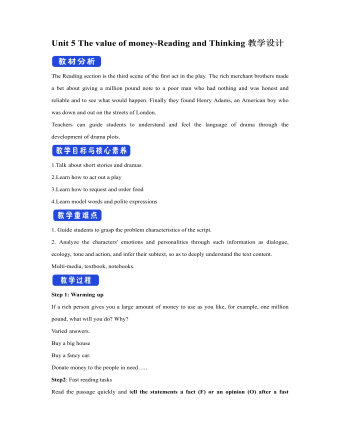
新人教版高中英语必修3Unit 5 The value of money-Reading and Thinking教学设计二
? Could you offer me some kind of work here?? I don’t want your charity, I just want an honest job.? Careless: I landed in Britain by accident.Step 7:Consolidation.? Find Henry? Roderick and Oliver were I .making a bet when they saw Henry, a poor young man. ? Know Henry? About a month ago, Henry was sailing and later he found himself carried out to sea by a strong wind. Fortunately, he 2.was spotted by a ship. And it was the ship that brought him to 3.England? Offer money to Henry ? Oliver and Roderick gave Henry a letter and told him that there was money in it. They 4.persuaded him to accept it, and made him 5.promise that it wouldn't be opened until 2 o'clock.Step 8:Language pointsa large amount of: a large quantity of; a great deal ofe.g. They bought a large amount of furniture before they moved their new house.make a bet: make an arrangement to risk money, etc. on an event of which the result is doubtful.e.g. We made a bet on the result of the match.permit sb to do something: allow somebody to do somethinge.g. My mother doesn’t permit me to ride in the street after it rained.by accident: as a result of chancee.g. I only found it by accident.stare at: look at somebody or something with the eyes wide open in a fixed gaze( in astonishment, wonder, fear, etc)to be honest: to tell you the truth; to be franke.g. To be honest, I don’t think we have a chance of winning.Step7 Homework:What do you think will happen to Henry? Will the bank-note help him or get him into trouble?

新人教版高中英语必修3Unit 5 The Value of Money-Reading for Writing教学设计二
2. 您能看到, 我头发太长了。You can see that my hair is much too long.3. 无论什么时候, 只要您想回来就回来。Please come back whenever you want.4. 您仅有很少的头发要理! You only have too little hair to cut !5. 为您服务是我的荣幸!It is my honour to serve you!Step 9 Writing(Henry is walking down the street when he sees a sign for a place that cuts hair. He decides to have it cut. )H=Henry B=BarberH: Good afternoon, I’d like to have my hair cut, if I may. (The barber looks at Henry’s hair and continues cutting another man’s hair. ) Er, I’d really like a haircut. As you can see it’s much too long. B: (in a rude manner) Yes, I can see that. Indeed, I can. H: Fine, well, I’ll have a seat then. (He sits in one of the barber’s chairs. The barber turns to look at Henry. )B: It’s quite expensive here, you know! Are you sure you can afford it?H: Yes. I think so. (After his hair is cut, the barber tells Henry how much he must pay. Henry shows the barber the bank note. )B: Why Mr. . . (looks shocked)H: Adams. Henry Adams. I’m sorry. I don’t have any change. B: Please don’t worry! (wearing a big smile) Nothing to worry about! Nothing at all! Please come back whenever you want, even if you only have too little hair to cut! It will be my honour to serve you!Step 10 Pair workExchange drafts with a partner. Use this checklist to help your partner revise his/her draft.1. Are all the elements of a play included and in good order ?2. Do the character use suitable language ?3. Are the stage directions clear and useful ?4. Is the plot clear and exciting enough ?
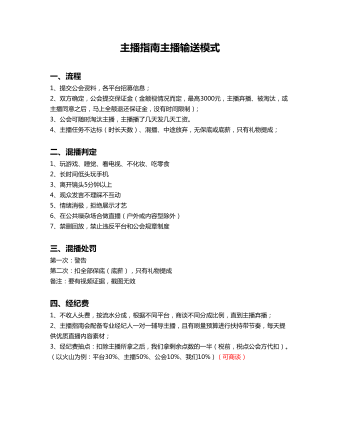
主播指南主播输送模式
一、流程1、提交公会资料,各平台招募信息;2、双方确定,公会提交保证金(金额视情况而定,最高3000元,主播弃播、被淘汰,或主播同意之后,马上全额退还保证金,没有时间限制);3、公会可随时淘汰主播,主播播了几天发几天工资。4、主播任务不达标(时长天数)、混播、中途放弃,无保底或底薪,只有礼物提成;二、混播判定1、玩游戏、睡觉、看电视、不化妆、吃零食2、长时间低头玩手机3、离开镜头5分钟以上4、观众发言不理睬不互动
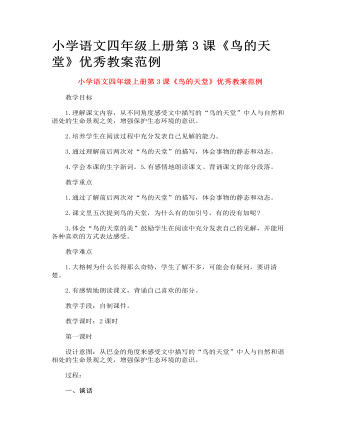
小学语文四年级上册第3课《鸟的天堂》优秀教案范例
首先我们进入到真正的鸟的天堂,也就是你们的天堂去看一下: 1.出示课件(12-13自然段的内容) 2.自由读这一部分,这一部分写出了“鸟的天堂”什么特点?(活泼可爱、鸟多)你是从哪些地方感悟到的?(自由发言) 3.当学生读到“应接不暇”一词时,问:这个词是什么意思呢?出示课件“群鸟纷飞”图帮助理解。 4.这一段主要应读出它的什么特点来呢?(热闹)对,这就是它的动态美,这一段主要写出了鸟的天堂的动态,让我们一起来读出它的动态美。(引导读“有的…有的…有的…”和“一只画眉鸟…那歌声真好听…”读出鸟的可爱;引导读“到处都是鸟声,到处都是鸟影”和“眼睛应接不暇…”读出鸟的多。) 5. 学生读完后问:这一只小鸟在兴奋地叫着,它可能在说什么呢?(可能在说,我在这里真快活。)假如你就是这只小鸟,你为什么会喜欢这个地方呢?让我们将自己的视角往小鸟生活的环境──大榕树身上聚集。
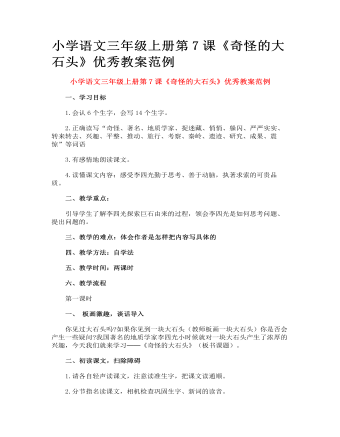
小学语文三年级上册第7课《奇怪的大石头》优秀教案范例
质疑解难 1.结合资料袋中的内容介绍本文主人公一李四光。 2.学生针对课文内容质疑,师生共同解疑。 (1)对预习认真,能主动、正确解疑的同学给予表扬。 (2)主要解决以下疑难: 陨石:大的流星在经过地球大气层时,没有完全烧毁坠落到地球上的含石质较多或全部为石质的陨星。 地质学家:从事地球物质形成和地壳构造研究,以探讨地球的形成和发展的科学家。 突兀:高耸。 第四纪:地质历史的最后一个纪。约250万年前至今。此时高纬度地区广泛地发生了多次冰川作用。 冰川:在高山或两极地区,积雪由于自身的压力变成冰块(或积雪融化、下渗冻结成冰块儿又因重力作用而沿着地面倾斜方面移动,这种移动的大冰块叫做冰川。在地质上的新生代第四纪,气候非常寒冷,世界上的许多地方被冰川覆盖,称第四纪冰川。 秦岭:横贯我国中部,东西走向的古老语皱断层山脉。我国地理上的南北分界线。分布有冰川槽谷、角峰等。
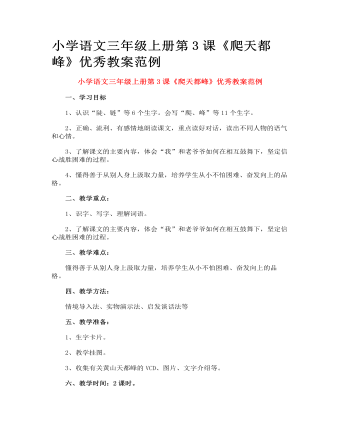
小学语文三年级上册第3课《爬天都峰》优秀教案范例
深入读议,体会“我”受鼓舞爬上峰顶 1、在爬山之前,望着又高又陡的天都峰,“我”心里是怎么想的?默读课文,圈点勾画,想想从哪些词语、句子中看出“我”有害怕畏惧的心理。 指名交流,出示并指导读好问句“我爬得上去吗?”、感叹句“真叫人发颤!”以及语气词“啊”“哩”等,读中体会“我”缺乏自信、畏惧退缩的心理。 2、结果“我”爬上峰顶了吗?自由读课文的第8至10自然段,出示“我”说的话,指名朗读。 3、“我”看到了什么从而下定决心爬上峰顶呢?自由读课文第3到7自然段,想想我的心理发生了怎样的变化。 a. 出示第4段重点句,引导学生深入讨论交流,从中感受到“我”受老爷爷爬山鼓励而下定决心爬上峰顶的内心活动。 b. 体会“我”的心理,指导朗读3、4自然段。 4、“我”是怎么爬的?自由读6、7自然段,画出描写爬山动作的词语。 a. 学生读书圈划。 b.学生交流。引导学生联系上下文,体会“奋力”是拼尽全身力气的意思。 从“攀着铁链”、“手脚并用向上爬”可以看出爬山的艰难。 c.引读第7段,从“终于”二字上体会爬得辛苦、上山后的喜悦。 d. 体会爬山的艰难、上山后的喜悦,指导朗读6、7两段。
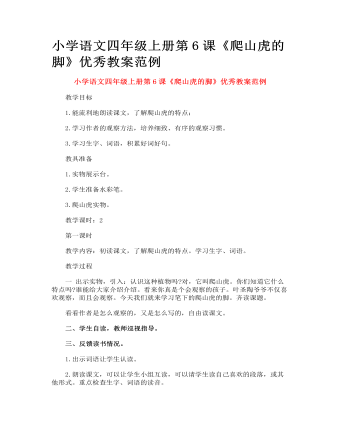
小学语文四年级上册第6课《爬山虎的脚》优秀教案范例
请同学们看实物。 1.你看到了什么? 2.有什么特点? 3.你能用一两句话把这些特点连起来说说吗? 4.叶圣陶爷爷笔下的爬山虎的叶子怎样呢?自由朗读第二自然段。 5.读了有什么感受?(美)哪些地方写的美?你喜欢哪句? 6.自己感受一下风吹时爬山虎叶子的美。做一做拂过、漾起的动作,你能读好这句话吗?想欣赏一下风吹爬山虎的样子吗? 7.老师指导读出美来。可以采取老师读前半句,学生补充后半句的读法,也可以男女生分组读,让学生充分感受爬山虎叶子的美。 8.作者为什么把叶子写的这么美呢?(认真观察)所以我们要学习作者认真仔细地观察事物的方法,养成良好的观察习惯。 爬山虎的叶子之所以生机勃勃地铺满墙,这跟它的脚有密切的联系,爬山虎的脚又是什么样的呢?
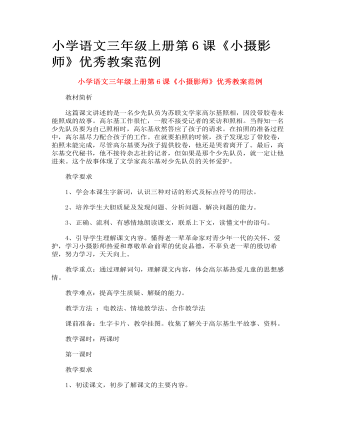
小学语文三年级上册第6课《小摄影师》优秀教案范例
介绍人物,导入新课 1、启发谈话。课前同学们自己已经读过了课文,查阅了有关资料,谁能向大家介绍一下高尔基? 2、学生之间交流收集的有关高尔基的资料。 3、师出示高尔基的画像,并归纳:高尔基(1886年~1936年),是苏联伟大的无产阶级文学家,世界著名的文学家。他写了很多书,发表了《童年》、《在人间》、《我的大学》、《母亲》等多部小说以及著名的散文诗《海燕》和一系列剧本。“书籍是人类进步的阶梯”这句脍炙人口的名言,就出自高尔基的笔下,全世界人民都很敬爱他。他的作品在我国广为流传,得到人们的喜爱。今天,我们来学习高尔基与一位小学生之间的故事:小摄影师。(板书,提示“摄”的读音。) 高尔基与小摄影师之间到底发生了什么事呢?我们下面来看课文